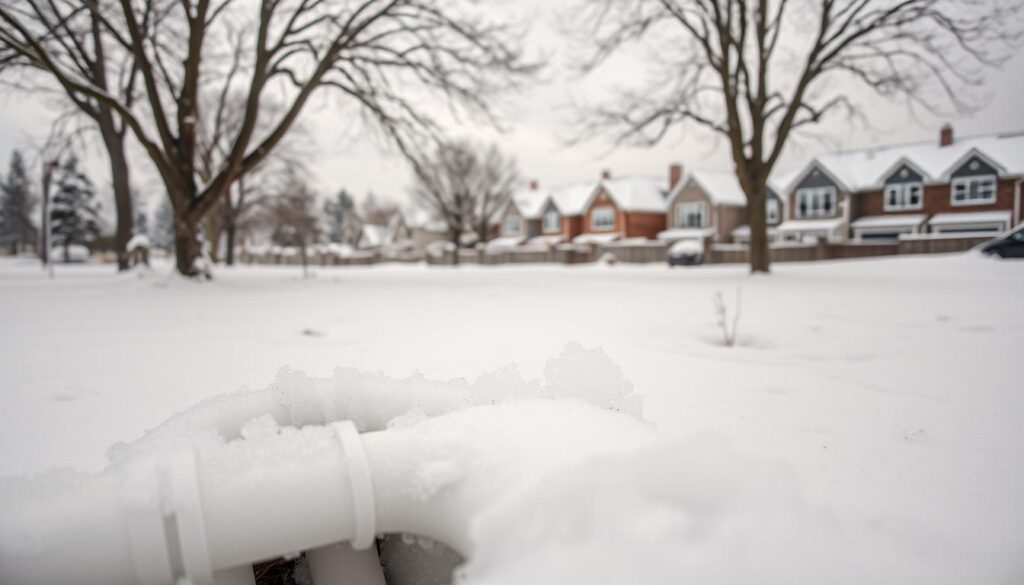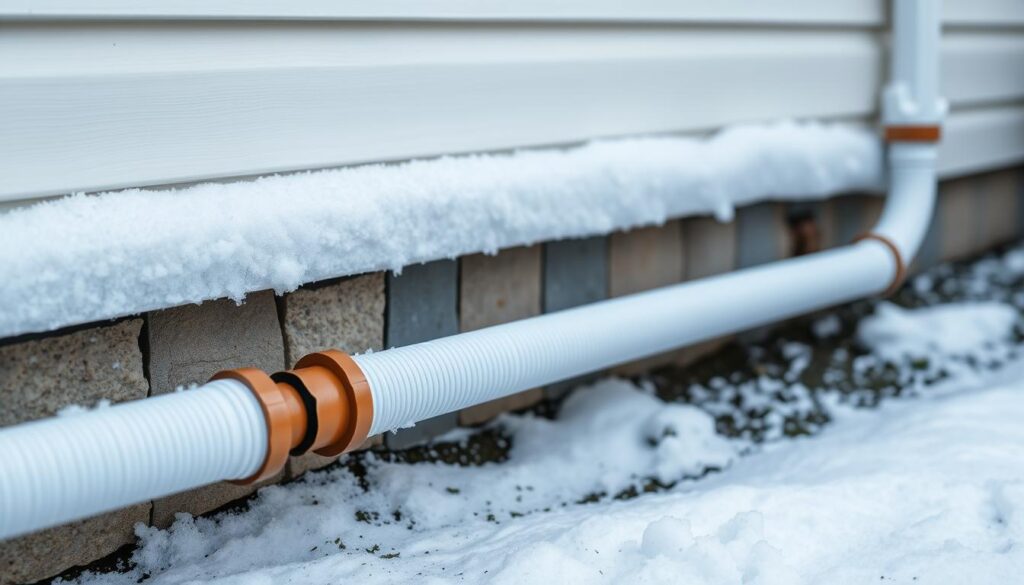Affiliate Disclosure
Plumber Guide Guys is a participant in the Amazon Services LLC Associates Program, an affiliate advertising program designed to provide a means for sites to earn advertising fees by advertising and linking to Amazon.
Does PEX Plumbing Freeze in Winter? Have you ever wondered if your home’s PEX plumbing can handle winter’s cold? Winter can be tough on homeowners, making it hard to keep plumbing systems from freezing.

PEX plumbing is known for its flexibility and durability. But the big question is: does PEX plumbing freeze in winter? Knowing the freezing point of PEX tubing is key to protecting your home’s water system.
While PEX pipes have many benefits, they’re not safe from extreme cold. The freezing point of PEX tubing can harm your home’s water system. It’s important to know how to stop damage before it happens.
Key Takeaways
- PEX pipes have specific temperature thresholds for freezing
- Understanding freeze risks can prevent costly home repairs
- Proper insulation is critical for protecting PEX plumbing
- Climate plays a significant role in freeze risk
- Early detection of freeze risks is important
Table of Contents
Understanding PEX Plumbing Systems
PEX (cross-linked polyethylene) plumbing is a new way to handle home water systems. It’s flexible and has changed how we think about water flow and pipe strength. PEX is becoming more popular in homes because of its benefits.
Innovative Piping Technology
PEX is different from old pipes because it’s flexible and strong. It can grow when it freezes, unlike other pipes. This means it can handle very cold temperatures without breaking.
Key Benefits of PEX Plumbing
- Superior temperature resistance
- Reduced installation complexity
- Lower material costs
- Minimal maintenance requirements
Common Residential Applications
PEX pipes are used in many home settings, such as:
- Radiant floor heating systems
- Domestic water distribution
- Hydronic heating networks
- Outdoor water line installations
PEX technology provides homeowners with a flexible, durable piping solution that adapts to challenging environmental conditions.
The special structure of PEX helps it handle extreme temperatures. Expanding pex when frozen is key to avoiding pipe failures in cold weather.
Does PEX Plumbing Freeze?
Knowing if PEX plumbing freezes is key for homeowners in cold areas. PEX pipes perform well in low temperatures but can freeze. They are most at risk when temperatures hit around 20 degrees Fahrenheit.
The freeze resistance of PEX plumbing depends on several key factors:
- Ambient temperature surrounding the pipes
- Insulation quality of the installation area
- Water content within the pipes
- Duration of extreme cold exposure
PEX pipe freeze protection needs careful planning. Unlike metal pipes, PEX can stretch a bit when water freezes. This helps prevent pipes from bursting right away.
“PEX pipes provide better freeze resistance compared to rigid piping systems, but they are not completely freeze-proof.” – Plumbing Expert
Your home’s climate and how you install PEX pipes matter a lot. Good insulation, smart pipe placement, and knowing your local weather are key. These steps help keep your plumbing safe during winter.
Freezing Temperature Threshold for PEX Pipes
Knowing the freezing point of PEX tubing is key to keeping your home’s plumbing safe in winter. It’s important to understand how PEX pipes handle extreme cold.
PEX pipes are more durable in cold weather than other materials. They start to worry when it gets below 20 degrees Fahrenheit.
Critical Temperature Points
Several factors affect when PEX pipes might freeze:
- Pipes are at risk when temperatures near 20°F
- Water inside starts to freeze at 32°F
- Complete freezing happens around 20°F or lower
Factors Affecting Freeze Risk
Many things can increase the chance of your PEX pipes freezing:
- Pipe location (exposed vs. insulated areas)
- Thickness of pipe insulation
- How long cold temperatures last
- Wind chill and weather outside
Regional Climate Considerations
Your area’s climate is very important for protecting PEX pipes in winter. Places with long cold spells need stronger protection for your plumbing.
“Prevention is always better than cure when it comes to protecting your pipes from freezing temperatures.” – Plumbing Expert
PEX vs Copper: Freeze Resistance Comparison
Homeowners need to know the big differences in how pipes handle cold weather. PEX pipes are way better at resisting freezing than copper pipes.
PEX pipes don’t lose heat as fast as copper pipes do. This is a big plus in cold places. It means they’re less likely to burst when it’s freezing.
- PEX pipes can expand up to three times their original diameter
- Copper pipes are rigid and less flexible
- PEX material absorbs freezing pressure better
How well a pipe handles cold is key to its durability. Copper pipes lose heat quickly, making them more prone to damage from sudden cold snaps. PEX pipes, on the other hand, stay strong even in extreme cold.
| Pipe Material | Freeze Resistance | Flexibility | Cost |
|---|---|---|---|
| PEX | Excellent | High | Lower |
| Copper | Limited | Low | Higher |
“PEX pipes represent a significant advancement in residential plumbing technology, providing better freeze protection.” – Plumbing Engineering Magazine
Choosing between PEX and copper depends on your home’s needs, your budget, and what you expect in the long run. Knowing the differences helps you pick the best for your plumbing.
Signs of Frozen PEX Water Lines
Winter can make your pex water lines vulnerable to freezing. Spotting early signs helps avoid expensive damage and pipe bursts. It’s key to know how pex expands when it freezes.
Finding frozen PEX pipes needs careful watching. Your plumbing system shows signs of trouble through specific indicators. These signs should not be ignored.
Visual Indicators
Start by looking for visual signs of frozen PEX pipes:
- Visible frost or ice on exterior pipe surfaces
- Condensation or slight bulging in pipe sections
- White or crystalline appearance on pipe exterior
Performance Issues
Performance problems can hint at freezing water lines:
- Significantly reduced water flow from faucets
- No water coming out when fixtures are turned on
- Unusual gurgling or banging sounds in pipes
Emergency Warning Signs
Some signs mean you need to act fast:
| Warning Sign | Potential Severity |
|---|---|
| Complete water stoppage | High risk of pipe damage |
| Visible pipe deformation | Immediate professional intervention needed |
| Unusual pipe sounds | Potential internal stress |
If you see these signs in your pex water lines, act quickly. This can prevent major damage. Always call a professional plumber if you think your pipes are frozen or at risk.
Preventing PEX Pipe Freezes in Winter

Keeping your home’s plumbing safe from winter’s cold is key. When it gets chilly, PEX pipes can freeze, causing damage. This is a big problem for your home’s plumbing.
To prevent this, you need to winterize your PEX plumbing. This means taking steps to keep your pipes from freezing. Here are some ways to do it:
- Insulate exposed pipes in unheated areas like basements, attics, and crawl spaces
- Seal air leaks near pipe locations to prevent cold drafts
- Maintain interior temperatures above 55°F, even when you’re away
- Disconnect and drain outdoor water hoses
Experts say a thorough approach to winterizing PEX plumbing is best. This includes using foam insulation, heat tape, and making sure pipes have good air flow.
| Prevention Method | Effectiveness Rating |
|---|---|
| Pipe Insulation | High (90% protection) |
| Interior Temperature Control | Medium (75% protection) |
| Heat Tape Application | High (85% protection) |
It’s cheaper to prevent pipe damage than to fix it. By using these winterizing methods, you can keep your plumbing safe. This saves you money on repairs.
Proper Insulation Techniques for PEX Plumbing
Keeping your PEX plumbing safe from freezing is key to a reliable water system at home. Insulating your pex pipes is vital to avoid water damage and expensive fixes in winter.
To prevent freeze damage, know where your plumbing is most at risk. Pipes in unheated areas need extra care to avoid freezing.
Essential Insulation Materials
- Foam pipe sleeves
- Fiberglass insulation wraps
- Self-sealing foam tape
- Heat tape for extreme cold regions
Critical Protection Zones
Some areas need more insulation for pex pipes:
- Attics: Usually the coldest part of a house
- Crawl spaces: Often exposed to outside temperatures
- Exterior walls: Directly hit by cold air
- Basement perimeters: Susceptible to temperature changes
For pex freeze damage prevention, create a solid insulation plan. High-quality foam sleeves are great at keeping pipes warm and safe from freezing.
Installation Tips
Make sure your insulation fits well and covers everything. Seal all gaps and edges for a solid layer. Check your insulation every year and replace any worn-out parts to keep your pipes safe.
Emergency Thawing Procedures

When PEX water lines freeze in winter, acting fast is key. It helps avoid serious damage. To prevent freeze damage, you need a smart plan to get water flowing again.
First, find where the pipe is frozen. Look for frost, bulges, or very cold spots. Spotting these early can help avoid pipe damage.
- Open faucets connected to the frozen pipe to release pressure
- Locate the section of frozen PEX pipe carefully
- Prepare gentle warming tools like a hairdryer or space heater
Safe thawing methods for PEX pipes in cold weather include:
- Use a hairdryer on low heat, moving constantly to distribute warmth evenly
- Apply warm towels around the frozen pipe section
- Use a space heater positioned at a safe distance from the pipe
| Thawing Method | Recommended Duration | Safety Level |
|---|---|---|
| Hairdryer | 15-20 minutes | High |
| Warm Towels | 20-30 minutes | Medium |
| Space Heater | 30-45 minutes | High |
Warning: Never use open flames or extremely high temperatures, as these can damage PEX pipes permanently.
If these methods fail or you’re unsure, call a professional plumber right away. They can stop major water line damage in extreme cold.
Long-term Protection Strategies
Winterizing PEX plumbing is all about planning to avoid pipe damage in cold months. It starts with knowing the right long-term strategies to boost pex pipe burst resistance.
Here are some important steps to protect your plumbing:
- Reroute pipes through heated interior spaces
- Improve home insulation around vulnerable pipe sections
- Install specialized frost-protection equipment
Moving pipes to warmer areas can greatly lower freeze risks. Moving PEX lines away from cold spots like crawl spaces and attics helps a lot. If moving isn’t an option, good insulation is your best friend.
Choose top-notch insulation for PEX plumbing in winter. Foam sleeves, heat tape, and fiberglass wrapping keep pipes warm where they’re most exposed.
Getting frost-free sillcocks installed is another smart move. They keep water from freezing in outdoor pipes, cutting down on freeze risks.
- Do annual plumbing checks
- Seal air leaks near pipes
- Keep indoor temperatures steady
Regular upkeep is essential for keeping PEX plumbing in top shape. By following these steps, you’ll shield your pipes from winter’s worst.
Conclusion
Knowing if PEX plumbing can freeze is key for homeowners in cold areas. PEX pipes are more flexible than old materials but can freeze. Taking steps to protect your PEX pipes can help avoid damage in winter.
Keeping your plumbing system strong starts with prevention. Insulate pipes well, route them smartly, and watch out for weak spots. Knowing how to protect your pipes helps keep your home’s water system safe.
Getting your PEX plumbing installed right and keeping it up is vital. Follow the right steps and stay up-to-date on local weather to avoid pipe freezing. Being ready for winter plumbing problems is your best defense.
PEX plumbing is a good choice for water systems because it’s reliable and flexible. With the right protection, you can handle winter’s challenges and keep your water flowing smoothly.
FAQ
What is PEX plumbing and how is it different from traditional pipes?
Can PEX pipes actually freeze?
At what temperature do PEX pipes start to freeze?
How does PEX compare to copper pipes in freezing conditions?
What are the signs that my PEX pipes might be frozen?
How can I prevent my PEX pipes from freezing?
What should I do if my PEX pipes freeze?
Are there long-term solutions to prevent PEX pipe freezing?
Is PEX plumbing recommended for cold climates?
How much does it cost to protect PEX pipes from freezing?
What is PEX plumbing and how is it different from traditional pipes?
Can PEX pipes actually freeze?
At what temperature do PEX pipes start to freeze?
How does PEX compare to copper pipes in freezing conditions?
What are the signs that my PEX pipes might be frozen?
How can I prevent my PEX pipes from freezing?
What should I do if my PEX pipes freeze?
Are there long-term solutions to prevent PEX pipe freezing?
Is PEX plumbing recommended for cold climates?
How much does it cost to protect PEX pipes from freezing?
FAQ
What is PEX plumbing and how is it different from traditional pipes?
PEX stands for Cross-linked Polyethylene. It’s a flexible, durable plastic used in plumbing. Unlike copper, PEX is more flexible and resistant to corrosion. It can also expand slightly, making it useful in many homes.
Can PEX pipes actually freeze?
Yes, PEX pipes can freeze. But they’re more resistant to freezing than copper. PEX can expand when water turns to ice. Yet, long exposure to cold can damage the pipes.
At what temperature do PEX pipes start to freeze?
PEX pipes start to freeze around 20°F (-6°C). But, the risk depends on the pipe’s location and insulation. Pipes in unheated areas or outside walls are most at risk.
How does PEX compare to copper pipes in freezing conditions?
PEX is more resistant to freezing than copper. It can expand when ice forms, reducing bursting risk. Copper pipes, being rigid, are more likely to crack when water freezes.
What are the signs that my PEX pipes might be frozen?
Look for signs like reduced water flow or unusual noises when turning faucets. Frost on visible pipes or no water from a fixture can also indicate freezing.
How can I prevent my PEX pipes from freezing?
Insulate your PEX pipes, and keep indoor temperatures steady. Seal air leaks and use heat tape in very cold spots. Proper installation also helps.
What should I do if my PEX pipes freeze?
If pipes freeze, use gentle heat like a hairdryer or heat tape. Never use open flames. If unsure, call a professional plumber.
Are there long-term solutions to prevent PEX pipe freezing?
Yes, reroute pipes away from cold spots and improve insulation. Install frost-free sillcocks and use insulation strategies. Regular maintenance and inspections help too.
Is PEX plumbing recommended for cold climates?
Yes, PEX is great for cold climates if installed and maintained right. Its flexibility and freeze-resistance outperform traditional materials in extreme cold.
How much does it cost to protect PEX pipes from freezing?
Costs depend on your home’s needs. Basic insulation costs
FAQ
What is PEX plumbing and how is it different from traditional pipes?
PEX stands for Cross-linked Polyethylene. It’s a flexible, durable plastic used in plumbing. Unlike copper, PEX is more flexible and resistant to corrosion. It can also expand slightly, making it useful in many homes.
Can PEX pipes actually freeze?
Yes, PEX pipes can freeze. But they’re more resistant to freezing than copper. PEX can expand when water turns to ice. Yet, long exposure to cold can damage the pipes.
At what temperature do PEX pipes start to freeze?
PEX pipes start to freeze around 20°F (-6°C). But, the risk depends on the pipe’s location and insulation. Pipes in unheated areas or outside walls are most at risk.
How does PEX compare to copper pipes in freezing conditions?
PEX is more resistant to freezing than copper. It can expand when ice forms, reducing bursting risk. Copper pipes, being rigid, are more likely to crack when water freezes.
What are the signs that my PEX pipes might be frozen?
Look for signs like reduced water flow or unusual noises when turning faucets. Frost on visible pipes or no water from a fixture can also indicate freezing.
How can I prevent my PEX pipes from freezing?
Insulate your PEX pipes, and keep indoor temperatures steady. Seal air leaks and use heat tape in very cold spots. Proper installation also helps.
What should I do if my PEX pipes freeze?
If pipes freeze, use gentle heat like a hairdryer or heat tape. Never use open flames. If unsure, call a professional plumber.
Are there long-term solutions to prevent PEX pipe freezing?
Yes, reroute pipes away from cold spots and improve insulation. Install frost-free sillcocks and use insulation strategies. Regular maintenance and inspections help too.
Is PEX plumbing recommended for cold climates?
Yes, PEX is great for cold climates if installed and maintained right. Its flexibility and freeze-resistance outperform traditional materials in extreme cold.
How much does it cost to protect PEX pipes from freezing?
Costs depend on your home’s needs. Basic insulation costs $1-$5 per foot. Professional measures might be $500-$2,000. This is cheaper than fixing water damage from burst pipes.
– per foot. Professional measures might be 0-,000. This is cheaper than fixing water damage from burst pipes.

